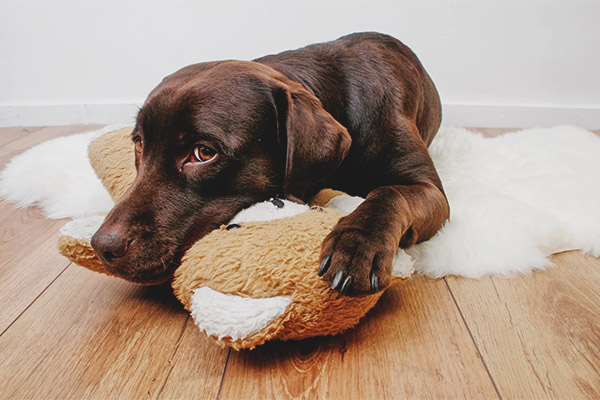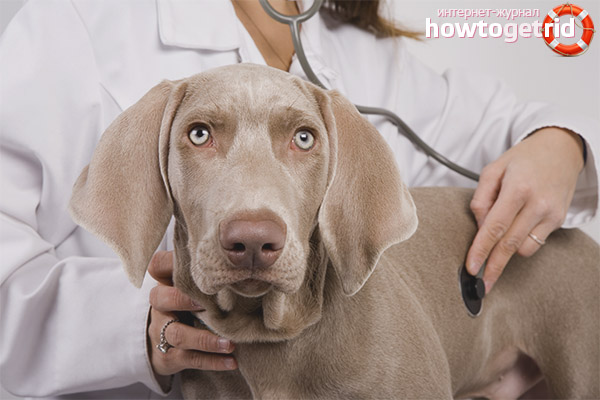The content of the article
All dogs sometimes get sick, but not always the owners can determine it in time, as the animals are very hardy and do not immediately pay attention to changes in the body. Even if the pet's stomach began to hurt, he could frolic, run and romp, not paying attention to the incidence that had begun.
The whole danger lies in the fact that only when the process has developed quite strongly, the painful spasms aggravated, the dog begins to show symptoms. As a rule, she begins to whine plaintively. And only at the reception at the vet the owner is surprised to learn that the disease lasts a long time.
Nevertheless, at the early stage, it is also possible to determine the onset of the disease, but the owner is required to be more attentive to the pet, reacting sensitively even to small unusual changes in behavior.
What to look for?
The most important symptoms that tell you to urgently contact a veterinarian:
- Complete lack of appetite, failure to try the most favorite food. If this happens, most often it signals a problem with digestion.
- Lost interest in mobile games. The pet goes out for a walk very reluctantly, on the street does not show interest in surrounding animals, often stops or lies down and does not want to get up.
- If you press on the stomach, the pet may whine or show unexpected aggression. Even a friendly dog can change during an illness, and not allow people to come near, trying to bite. It is impossible to punish such behavior, since it is severe pain that causes irritability and aggressiveness.
- The dog stopped communicating with households, crouched in a corner and moaning plaintively. He does not want to go out for a walk.
- Changed gait. The dog walks very slowly, most often stooping or lifting the back part while moving and constantly whimpering.
- The animal periodically shudders from pain.
If there are such changes in behavior, you should check the physiological state:
- Does your pet have diarrhea or constipation? The stool may be too frequent and watery or, conversely, rare. If such pathologies are detected, gases constantly accumulate, which means that the gastrointestinal tract needs urgent examination and treatment.
- What happens after the next meal: the disease progresses, if vomiting begins after eating, food remains out in large chunks, undigested, or mucus appears.
- From the mouth it smells unpleasant, the smell is putrid.
- The nose is warm.
- Eyes begin to turn sour.
- The abdomen is noticeably swollen and hard.
To help your pet, you need the help of a veterinarian.
What can cause abdominal pain
Before starting treatment, the veterinarian must make an accurate diagnosis. The causes of violations and pain can be many. In most cases, it is either food poisoning, which is quickly treated and completely disappears after therapy, or an improper or irregular diet. But serious pathologies also occur, for example, if a tumor develops in the abdominal cavity, a dangerous infection has entered the body, or the disease is predetermined by a genetic predisposition.
Some stomach problems can be avoided.But for this you should know that the pain in the abdomen may appear due to:
- Worm invasion.
- Poisoning. It can be caused by low-quality products, especially in summer, when viruses and bacteria develop faster. Some dogs like to pick up a discarded bone on the street, or, until the owner sees it, visit a public trash can. As a result, inflammatory processes begin to appear on the mucous membranes.
- Intrusion into the body of pathogenic microbes. This suggests an intestinal infection, and it is necessary to get rid of it, since the waste products of microorganisms poison not only the intestines and stomach, but also other organs.
- Poor quality feed. Harmful additives, expired use provoke the occurrence of diseases.
- The transition to a new type of food. As long as the adaptation lasts, stomach discomfort may occur.
- Food allergies. In dogs, too, non-perception of any product may occur, and inflammation may occur in the wall of the stomach or intestines.
- Ingestion into a foreign body. Even a small object causes cramps and sharp pain.
- OvereatingIf the pet likes to eat too nourishingly, the digestive organs do not have time to process the leftover food. The stomach is swollen and starts to hurt, nausea can occur, as the food is a heavy burden.
- Rare walks. If the pet has to endure for a long time until it is taken out, the act of defecation is violated. As a result, fecal masses are compacted, which leads to injuries of the intestinal mucosa, the development of inflammation and the appearance of pain.
- Damage to internal organs if mechanical injury occurred.
Periodic pains can occur if a dog is used to eating food from a bowl too quickly. Food enters the empty stomach rapidly, which causes spasms.
If a dog has pancreatitis, then if you eat the wrong diet, you will have severe abdominal pain, the pet will lose its appetite, it will become very sluggish. Impaired pancreatic function often provokes not only pain, but also constipation.
A disease such as cystitis is also a cause of abdominal discomfort. Inflammation of the urinary system causes pain in the lower abdomen. And if this disease is not treated in time, the kidney can become inflamed in the dog.
There are pains in the abdomen, if the dog had to be treated for a long time with various drugs, as a result of which intestinal dysbiosis appeared, that is, the ratio of microflora in it was disrupted. This means that the processes of decay have intensified, harmful substances accumulate more and more, and the motor activity of this organ decreases sharply. This most often leads to constipation, which also contributes to the occurrence of pain.
In the dog’s diet, veterinarians do not recommend the inclusion of certain foods that may cause colic, bloating and gas formation. These are, above all, cereals - barley and corn, as well as a family of legumes and sweetness from the dough.
Is there any cause for concern?
If the pet is worried about pain due to improper diet, they will pass, if properly balanced. It will take several days to recover, and the treatment in this case is mostly not necessary.
But, if pain occurs for a long time, the dog’s stomach is hard, and when the owner tries to touch the place that the pet is so worried about, he hears a growl in response,then it's time to visit the veterinary clinic. Only timely specialist assistance will help to understand the problem and cure the pet.
Why home treatment does not help?
A common mistake of pet owners is to try to cure them at home. Dog give activated carbon, rehydron, but, silos, do cleansing enemas. Indeed, these methods help, but only for a short time. And then all the symptoms of the disease in most cases return.
Medications can be harmful if given to an animal before being taken by a veterinarian, as pain will be reduced and it will be difficult to establish an accurate diagnosis.
To help the animal at home, a light massage can be given before the examination of the vet, necessarily clockwise, if this makes the dog easier. It is possible to use a slightly heated flannel fabric for the massage.
Visit to a specialist
For proper treatment, a comprehensive examination of the patient at the veterinary clinic should be held. Sometimes it is enough to feel the abdominal cavity to determine if a tumor has arisen there or if there is no intestinal obstruction.
But most often the veterinarian offers a more detailed examination to determine the diagnosis:
- Take a urine test to the laboratory to determine the presence of bacteria and the content of leukocytes.
- Bacterial urine culture. This will make it possible to determine the causative agent of the disease.
- Ultrasound. Such a survey allows you to find violations in the work of internal organs.
Additional studies may also be needed, for example, x-rays, blood and feces.
If the veterinarian finds out that the pain is caused by food poisoning, or for a long time, the feeding was not carried out correctly, diet therapy and pills are prescribed. They are selected depending on the characteristics of the breed of dog. Injections may also be prescribed.
Depending on the diagnosis, antimicrobial and anti-inflammatory drugs may be prescribed to remove inflammation.
Surgical intervention is usually required only in cases when there is an object in the stomach or a tumor needs to be removed.
Prevention is important!
- It is necessary to feed the dog only with fresh, high-quality food, excluding fried, smoked and fatty foods.From the very young age it is necessary to wean the pet to lift the remains of food or any objects on the street.
- To rid the pet of worms, every six months you need to give him a special pill.
- During the walk, care should be taken that the animal is not injured, otherwise damage to internal organs can cause many diseases.
Veterinarians warn that the abdominal pain in dogs should not be ignored, and the sooner the therapy is prescribed, the sooner the pain will pass.
Video: Diseases of the gastrointestinal tract in dogs












To send